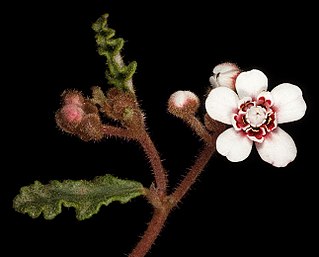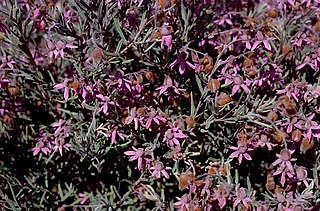
Calytrix depressa is a species of flowering plant in the myrtle family Myrtaceae and is endemic to the south-west of Western Australia. It is a glabrous shrub with linear to lance-shaped leaves and mauve to violet or yellow flowers with 35 to 75 stamens in several rows.

Thomasia sarotes is a species of flowering plant in the family Malvaceae. It is an upright, spreading shrub with purple, pink to mauve or white flowers and is endemic to the south-west of Western Australia.

Thomasia pygmaea, commonly known as tiny thomasia, is a species of flowering plant in the family Malvaceae and is endemic to southern Western Australia. It is a low, dense, compact shrub with broadly heart-shaped to egg-shaped or more or less round leaves and pink to purple flowers.

Lysiosepalum involucratum is a species of flowering plant in the family Malvaceae and is endemic to the south-west of Western Australia. It is dense, compact or spreading shrub with its young branches covered with woolly, star-shaped hairs, and has narrowly egg-shaped leaves and purple flowers usually in groups of 2 to 6.

Guichenotia macrantha, commonly known as large-flowered guichenotia, is a species of flowering plant in the family Malvaceae. It is a shrub with grey-green leaves, mauve flowers and is endemic to Western Australia.

Hypocalymma tetrapterum, commonly known as papillose myrtle, is a species of flowering plant in the myrtle family Myrtaceae, and is endemic to the a restricted area in the south-west of Western Australia. It is a shrub, with narrowly egg-shaped leaves with the narrower end towards the base, and white yellow flowers with 20 to 35 stamens in several rows.

Boronia pulchella, commonly known as the pink boronia, is a plant in the citrus family Rutaceae, and is endemic to a small area in the south-west of Western Australia. It is a slender shrub with rod-like stems, pinnate leaves and deep pink, four-petalled flowers.

Androcalva pulchella is a species of flowering plant in the family Malvaceae and is endemic to the south-west of Western Australia. It is a small shrub with egg-shaped, elliptic or oblong leaves, the edges wavy, lobed or toothed, and clusters of two to seven white and deep pink flowers.
Pultenaea adunca is a species of flowering plant in the family Fabaceae and is endemic to the south of Western Australia. It is an erect, spindly shrub with hairy, needle-shaped leaves and yellow and red flowers.

Lasiopetalum quinquenervium is a species of flowering plant in the family Malvaceae and is endemic to the south of Western Australia. It is an erect, spreading shrub with hairy stems and leaves, egg-shaped leaves and pink or white flowers.
Pimelea drummondii is a species of flowering plant in the family Thymelaeaceae and is endemic to near-coastal areas of southern Western Australia. It is an erect, slender shrub with narrowly elliptic or elliptic leaves arranged in opposite pairs, and white or cream-coloured flowers surrounded by 3 or 4 pairs of pale green to yellowish involucral bracts.

Thomasia brachystachys is a species of flowering plant in the family Malvaceae and is endemic to the Southwest Australia south-west of Western Australia. It is an open, erect shrub with egg-shaped to heart-shaped leaves and pink to mauve flowers.

Thomasia rugosa, commonly known as wrinkled leaf thomasia, is a species of flowering plant in the family Malvaceae and is endemic to the south-west of Western Australia. It has wrinkled, lance-shaped to egg-shaped leaves with wavy edges, and pink to mauve flowers.

Thomasia stelligera is a species of flowering plant in the family Malvaceae and is endemic to the south-west of Western Australia. It is a low, spreading shrub with scattered, narrowly oblong leaves, and racemes of mauve flowers.
Thomasia triloba is a species of flowering plant in the family Malvaceae and is endemic to the south-west of Western Australia. It is an erect, open shrub that typically grows to a height of 0.4–1 m and has pink or purple flowers in October and November. The species was first formally described in 1846 by Nikolai Turczaninow in the Bulletin de la Société Impériale des Naturalistes de Moscou from specimens collected by James Drummond. This species of thomasia is listed as "Priority One" by the Government of Western Australia Department of Biodiversity, Conservation and Attractions, meaning that it is known from only one or a few locations which are potentially at risk, but may be extinct.

Androcalva cuneata is a species of flowering plant in the family Malvaceae and is endemic to the south-west of Western Australia. It is a low, spreading, densely hairy shrub that sometimes forms suckers and has wedge-shaped leaves and clusters of 5 to 15 pink flowers.

Commersonia densiflora is a species of flowering plant in the family Malvaceae and endemic to the south-west of Western Australia. It is a dense, low-growing shrub with pinnate, elliptic to narrowly oblong, prominently veined leaves, and white flowers in clusters of 100 or more.
Commersonia rotundifolia, commonly known as round-leaved rulingia, is a species of flowering plant in the family Malvaceae and endemic to the south-west of Western Australia. It is an upright, openly-branched shrub with elliptic to round leaves with wavy edges, and white flowers in clusters of 3 to 10.

Androcalva crispa, commonly known as crisped leaf commersonia, is a species of flowering plant in the family Malvaceae and is endemic to the south-west of Western Australia. It is a prostrate shrub that forms suckers from rhizomes and has densely new growth, clusters of lobed, egg-shaped or oblong leaves with wavy, serrated edges, and groups of white and pinkish-purple flowers.

Guichenotia angustifolia is a species of flowering plant in the family Malvaceae and is endemic to the south-west of Western Australia. It is an erect, prostrate or climbing shrub with hairy young growth, hairy, oblong to linear leaves and pink to mauve flowers.
















